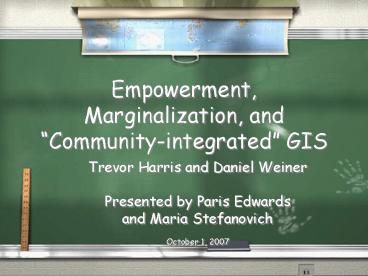Empowerment, Marginalization, and - PowerPoint PPT Presentation
1 / 22
Title:
Empowerment, Marginalization, and
Description:
better and more rapid access to public data. the ability to present data more persuasively ... Concern for citizen preparedness to deal with spatial data and ... – PowerPoint PPT presentation
Number of Views:45
Avg rating:3.0/5.0
Title: Empowerment, Marginalization, and
1
Empowerment, Marginalization, and
Community-integrated GIS
- Trevor Harris and Daniel Weiner
- Presented by Paris Edwards
- and Maria Stefanovich
- October 1, 2007
2
What is GIS?
- http//www.youtube.com/watch?vxLjtzxXTpN0
3
Public Participation GIS
- is an interdisciplinary research, community
development and environmental stewardship tool
grounded in value and ethical frameworks that
promote social justice, ecological
sustainability, improvement of quality of life,
redistributive justice, nurturing of civil
society, etc - (By Doug Aberley and Renee Sieber)
4
Hypothesis
- GIS is a contradictory technology that
simultaneously empowers and marginalizes people
and communities. Therefore, the societal impacts
of GIS are dependent on particular configurations
of place-based - historical,
- socio-economic,
- political and
- technical conditions
5
National Research Council Predictions
- Wide-spread use of GIS by 2010
- increased citizen involvement
- better and more rapid access to public data
- the ability to present data more persuasively
- improved communications and technologies to
support collaboration - power of the Internet and the WWW for rapid
publication and dissemination of ideas and data
6
National Research Council Predictions (cont.)
- Possible restrictions on public access to data
and increasing privatization of spatial data - Concern for citizen preparedness to deal with
spatial data and think spatially
7
GIS and Society
- quiet revolution
- Use of GIS widening- need for demonstration
projects - Issues arise concerning the interpretation of
alternative data
8
GIS and Society
- Top-down, elitist, technicist
- GISs dualistic nature - using data to both
empower and marginalize - Examples red-lining and gerrymandering
9
The anti-geography
- Breakdown between knowledge and data
- Can GIS be value-neutral?
- Is GIS a tool or a science?
10
Access to Data
- Commodification of data
- Privacy and use of geodemographic data
11
Challenges
- Knowledge distortion
- Democratic involvement as an antidote
- Agencies bias
- Accountability
12
Attempts to overcome GIS challenges
- Initiative 19
- Democratizing access - how can GIS be modified
for that purpose?
13
PPGIS CASE STUDIES
- The Eagle Project (environmental health and risk
assessment) - Peruvian Amazon (economic development strategies)
14
Patterns
- Control, Access, Results
- Two central themes in the success of PPGIS
projects are accountability and sustainability.
15
Interactive Online Mapping
- - How accessible is it?
- www.interrain.org
16
Community Use of GIS
- Hutchison and Toledano
- demand driven vs. technology driven
- Is it possible to avoid the top down approach
to introducing technology?
17
GIS and Society
- The integration of local knowledge and the
representation of non-hegemonic epistemologies of
space, environment, and territory are complex and
potentially contradictory aspects of alternative
GIS production and use. - Can GIS accurately translate non-empirical data?
(Rundstrom)
18
Technological Repercussions
- Disenfranchizing indigenous populations and the
knowledge they provide by replacing the
traditional methods with technology - What is lost in translation?
19
Community Integrated GIS
- Opens up involvement to those outside of the
community - Integrates spatial and non-spatial data to
incorporate alternative local knowledge - Displays information in forms alternative to maps
for diversity in representation - Allows inclusion of data that cannot be easily
translated to map form - Does the production process seem feasible?
20
Project Scope
- Accessibility to GIS on the internet
- Could telecommunication be the key to increasing
access to GIS?
21
Conclusion
- Skepticism about empowerment given the dualistic
nature of GIS to both marginalize and empower - Place-based approach to the use of GIS
- Relevance of GIS information is temporary and
dependent upon power configurations
22
Points to Ponder
- Issues of hegemony, democracy, privacy are they
really avoidable? - Is cultural heritage at risk? Do risks outnumber
the benefits? - What about the age of the article? Are these
issues still relevant nine years later? Have the
predictions of widespread use of GIS come true?































